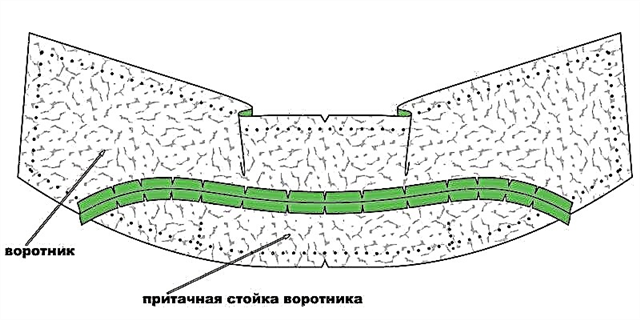Many fashionistas have already begun to prepare for the spring-summer season and sew romantic dresses from fine silk and delicate chiffon. Sewing from delicate fabrics is not easy, but the result is worth it!

The processing of the neckline in products made of thin fabrics can cause certain difficulties.

Using an example of a dress made from crushed chiffon crepe, we will show another way of processing a V-shaped neck by turning.
Full-cut neckline and armhole in a sleeveless dress
You will need:
- thin adhesive doublerin;
- ruler;
- tailor pins;
- scissors for fabric;
- thread and needle for sewing.

Stitch the shoulder seams of the product and process the allowances. For convenience, it is better not to grind the side seams for now.


Prepare a pattern for turning the neck of the shelf and back.
To do this, on the pattern of the shelf, apply marking at a distance of 4 cm from the neck.

Draw a line for the grind. Below the neckline, extend the line down to the waist along the midline line about 2 cm from it. This part will be used for additional fastening of the bottom hem if the seam is provided along the waist line in the product. If the product does not have a seam at the waist, then cut the trim in the usual way - with the corner below.

Cut out the detail of the front neckline.


Similarly, grind the back of the neck.

Finishing details are ready, now they are presented without allowances.

Cut out the stitching details from the fabric, providing for allowances of 1 cm in the neck, 1 cm in the shoulder sections, and 0.5 cm in the outside of the stitching.
Cut exactly the same parts from doubler.

Fold the fabric and doubler stitching details with the front sides (the adhesive side of the doublerin will be outside) and fix with pins.

Chip off parts from the main fabric and from doubler only in the area of the shoulder sections and connect the front sections of the shoulder sections of the parts, as shown in the photo.

Stitch the shoulder sections separately on the fabric edge and on the doubler parts.
Flatten the allowances on the fabric edge, lay out the allowances of the doublerin parts in different directions.
And chip the facing back to each other, as shown in the photo.

Chip or sweep parts along the outer edge of the grind.

Lay the stitch along the outer edge of the overlay at a distance of 0.5 cm from the cut.
Cut the allowance to a width of ~ 2-3 mm.

Now you need to unscrew the part and sweep the outer edge of the facing (where the line was laid) with a small transition edging on the wrong side.

And now you can iron the part, so it will be duplicated. The tag can be deleted.
There was an open cut below the underside.

This is the wrong side of the facing.


Stitch the hem at a distance of 1-2 mm from the outer edge, stitch length ~ 3 mm.

Duplicate the neck of the product with a thin strip of doubler, cut along the share.

Place the facing over the neck with the right side facing the front side and secure with pins or basting.

Lay the stitch at a distance of 1 cm. In both directions from the corner, perform the fastening.

In the corner, cut an allowance, not reaching 1 mm to the stitch.

Sew the hem for an allowance of 1-2 mm from the seam, stitch length 3-4 mm.

Unscrew the seam on the wrong side with a small adapter piping and take it.

Iron the hem along the entire neckline.

Perform short tacking, exactly falling into the shoulder seams.

It remains to fix the lower part of the casing.

In this case, it is fixed by the line of attaching the drawstring. You can also grab it into the seam connecting the bodice and the skirt of the product.Thanks to this detail, the sharpening will be additionally fixed from below and will not turn out when putting on the thing.

It looks like a finished finish from the inside.

Done!
Neck Processing Methods
Throat cut processing
How to process the neck with a French edging
The author of the master class and photo: Daria Tabatchikova

By education, Daria is a PR specialist and economist, but several years ago she devoted herself entirely to her favorite business - sewing.
She learned to sew from magazines, books and using the Internet, there are also sewing courses in the arsenal, but Daria refers herself to self-taught. She loves to study specialized sewing literature from different years and countries, and then put her knowledge into practice.
At the end of 2017, Daria became the winner of the festive contest from BurdaStyle.ru.
She leads her Instagram page and VKontakte group.
Material prepared by Julia Dekanova



